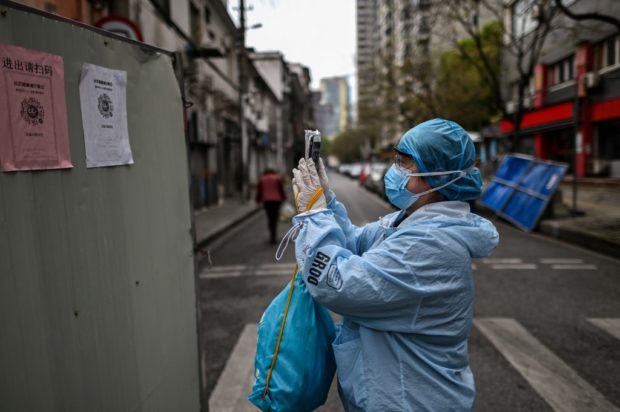New Wuhan coronavirus infections show ‘silent carriers’ remain biggest problem

This file photo taken on April 11, 2020 shows a woman wearing a protective suit and face mask amid the COVID-19 coronavirus pandemic using her phone to scan a Wuhan city health code before entering a residential compound in Wuhan, China’s central Hubei province. Photo by HECTOR RETAMAL / AFP
BEIJING — Six new Covid-19 cases, all of whom were local transmissions, have surfaced in Wuhan barely two weeks after the city in central China declared that the last of its patients had been discharged from hospital.
Local health authorities on Tuesday (May 12) ordered the entire city of 11 million to undergo nucleic acid testing over a 10-day period in a bid to arrest the spread of the coronavirus, which causes Covid-19, and, more importantly, prevent a second wave of infections just a month after it lifted a lockdown.
Wuhan was the epicenter of an outbreak of the coronavirus in China.
As details of city-wide testing are being ironed out, the fresh cases highlight the challenges of restarting the nation’s economy – which is facing its worst contraction since 1992 – while still grappling with a disease that is still prevalent in at least three provinces, as asymptomatic patients continue surfacing.
It remains unclear how the virus entered the community but it was first detected in an 89-year-old man who exhibited symptoms in late March and was self-medicating.
Article continues after this advertisementWhen he visited the hospital for other ailments earlier this month, doctors tested and found him positive for Covid-19. Contact tracing led to other residents in the neighborhood being tested, turning up dozens of asymptomatic cases who were quarantined.
Article continues after this advertisementBut, under China’s tabulation system, patients who do not show symptoms but who tested positive in the nucleic acid test are not added to the official tally.
The tally therefore can be misleading because around a dozen asymptomatic cases have been reported daily in Wuhan since such figures were released beginning April 1. As of Tuesday, there were still 589 such patients under “medical observation”.
“Cross-infection at community level in the city has not yet been eliminated, which highlights the challenge of preventing those who have the virus without displaying any symptoms from infecting others,” the official China Daily said in an editorial on Tuesday.
But a top scientist from the Chinese Centre for Disease Control and Prevention, Dr Wu Zunyou, has said testing the entire population was “unnecessary” and that mass testing should be carried out only on critical groups that have a higher exposure to the virus.
Another expert, Dr Gregory C. Gray, a professor of medicine at the Global Health and Environmental Health unit at Duke University in the US , has described asymptomatic patients as the “major problem” for doctors fighting Covid-19.
“While mass testing (molecular or serologic) would help identify cryptic pockets of infection, it would need to be periodically repeated and thus expensive and very challenging to maintain,” he told The Straits Times.
“I do not see an easy, low-cost solution to stopping transmission short of a mass vaccine program which too may also need to be repeated every several years to maintain immunity,” he added.
There is also the issue of capacity for Wuhan with official statistics showing that 1.03 million people had undergone nucleic acid tests as at the end of April.
But the 53 labs and 211 testing clinics in the city can process only 46,000 samples a day, far short of the nearly one million per day needed to meet the target of testing the city’s entire population.
Ultimately, the nub of the issue in China – and the rest of the world as cities reopen – remains how best to deal with asymptomatic carriers while trying to restart the economy.
For more news about the novel coronavirus click here.
What you need to know about Coronavirus.
For more information on COVID-19, call the DOH Hotline: (02) 86517800 local 1149/1150.
The Inquirer Foundation supports our healthcare frontliners and is still accepting cash donations to be deposited at Banco de Oro (BDO) current account #007960018860 or donate through PayMaya using this link.